What if you could choose which days to be sick? Now let’s be real, you…

5 Gross Motor Activities for Brain Development
Gross motor activities are great for developing the right side of our brain. Our brain has specific developmental ‘windows’ in which growth is more emphasized on one hemisphere.
During the first 2-3 years of life, growth is more centered on the right side of the brain, and then shifts to the left hemisphere for the following 2-3 years. This jumping back and forth continues into our teenage years.
The right hemisphere is the central hub for skills such as:
· Creative, abstract thinking and imaginative play
· Big picture/general details
· Gross motor skills (large muscle groups)
· Non-verbal communication
· Deep touch processing
· Emotional Skills
· Doing (practical)
Challenge your child’s ability to enhance their gross motor skills by engaging them in the following gross motor activities:
1) Paper plate skating
Have you child stand on or tape paper plates to their feet. This will reduce friction and allow them to glide around hardwood or carpeted surfaces. While they glide around the room, they will be engaging the large muscles groups in the legs and buttocks while activating the postural stability muscles in their spine, shoulders and neck. Make this activity more fun by creating an obstacle course and timing how quickly each child can make it through the maze.
2) Bean Bag Toss
Work on letters, numbers, shapes or colors, by taping signs to your set of stairs. Call out an object and have your child toss their bean bag onto that stair to work on hand-eye coordination and throwing motions.
3) Balloon Volleyball/Tennis
Using string or tape, make a divider and eye level across a room. Blow up a balloon and play as you would normal volleyball. You can play seated, standing, on scooter boards, with pool noodles, rolling chairs or exercise balls. First team to 10 points wins. The balloon cannot be hit by the same player consecutively and the balloon can only be hit 5 times per volley. You can also create ‘racquets’ using popsicle sticks and paper plates for a ‘tennis’ version of this game.
4) Animal Movements
Practice walking like your favorite animal!
- Gorilla – Walk around in a squatted position using your feet and fists.
- Elephant – Interlock your hands and bend forward at the waist, allowing your arms to dangle. Sway your arms back and forth like a trunk while walking forward
- Cat/camel – Get down into a hands and knees position. Arch your back like a cat while tucking your chin to your chest. Then extend your head while dropping your belly toward the floor but remaining on your hands and knees.
- Snake – Slither around on the ground using your shoulders and hips with your arms at your side.
- Rabbit – Hop around in a standing or squatted position with your hands bent inward toward your chest.
- Frog – Squat down with your hands on the ground between your feet. Explosive-jump upward with your legs and hands, propelling yourself forward.
- Bear – Start on your hands and knees. Bring your feet up to walk around on your hands and feet with your hips up in the air. Walk forward using the same side arm and leg.
- Crab – Lay on your back. Push your hips and back off the ground using your legs and arms. Walk around with your back off the ground.
- Duck – Waddle around in a squatted position.
- Giraffe – Similar to elephant, interlock your fingers to make the neck of a giraffe. Swing your arms back and forth while walking around.
- Starfish – Start by squatting in a ball with your chin tucked. Jump up as high as you can while spreading your arms and legs like a jumping jack while extending your head.
- Flamingo – Balance on one leg like a flamingo.
5) Activity Cube
Create a giant die using cardboard boxes and an activity sheet. Wrap the cube with colored construction paper or draw dots on the cube, to look like a die. Roll the giant die and perform the activity corresponding to that number or color on the activity sheet. Allow your children to stretch their imagination by allowing them to create the activities.
Sample gross motor activities are: hop on one foot, jumping jacks, push-ups, burpees, snow angels, army crawling, balance heel-to-toe, walk in a straight line heel-to-toe, spin in circles, do arm and leg circles, balance on one leg, flap your arms like a bird, do a somersault, do a cartwheel, planks.



